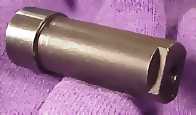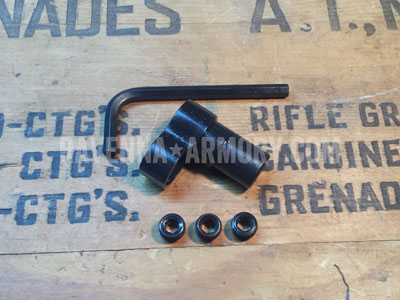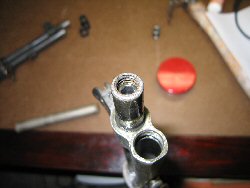M1 Garand Blank Adapting FAQ
Written: 7/25/2007
Updated: 8/29/2010
Updated: 7/5/2015
Author: Chris Guska
One of the constant questions that arise among new re-enactors is:
Q: How do I blank adapt my Garand, and which blank adapter is best?
A: It depends.
The purpose of this article is to allow you to make an informed decision and choice about the various blank adapters currently on the market. I will address underlying principle, function, safety, aesthetics and cost.
Not all blank adapters were created the same. Some have unique advantages or disadvantages concerning appearance, safety, function and cost.
Q: How does a blank adapter work?
A: The M1 Garand is a semi-automatic gas operated rifle. Essentially when live ammunition is fired, the gasses of combustion are trapped behind the bullet as it makes its way down the barrel. Near the muzzle, some of those gasses are re-directed through a hole in the barrel into the gas cylinder, which push on a piston head. That piston head is attached to the operating rod, which cycles the action of the Garand. When firing blanks, there is no bullet to trap gas behind and no way of creating the requisite pressure to push on that piston and cycle the action. The blank adapter reduces the opening (aperture) at the muzzle, trapping gases momentarily, long enough for the requisite pressure to be built and operate the action.
Further explanation of how the M1 Garand operates can be found at: http://www.garandflash.com
Q: Why would you want an “adjustable” blank adapter?
A: Not all blanks were created the same. Some blanks have more powder, or faster burning powder than others. These blanks are considered “hotter” and create a higher pressure of gasses in the barrel. With higher pressures, a smaller aperture at the muzzle is no longer needed to cycle the blanks. Being able to adjust the size of the aperture in these circumstances is preferred, as less wear is put on the rifle, in addition to less stress is being put on the threads that hold the BFA on. High pressures and an aperture that is too small will cause the BFA, and potentially the whole gas cylinder to be blown off the rifle.
Q: How do you gauge the safety of a blank adapter?
A: It depends. Everyone has their opinion on what is best and what is safest. Much of the safety factor of blank adapters depend on a myriad of factors, including but not limited to: The condition of your rifle, barrel, threads and gas system, The quality and type of metal used in the blank adapter, The tolerances to which the blank adapter was made, The skill of the machinist, The age of the adapter, The history of the adapter (how many blanks were fired through it, as well as what kind of blanks), The proper installation of the adapter (has it been over-torqued onto the barrel previously? Has it been accidentally cross threaded? Is it properly tightened down? Is it insufficiently tightened down? Have additional means of securing the adapter been used such as Loc-tite? )
Finally, the last factor in safety is YOU, the user. Safety begins and ends with the user. Blanks are dangerous. Blank adapters are only as safe as their user.
All of the blank adapters listed will safely function properly, with the correct blanks, with the correct aperture. No one adapter is truly “safer than the rest” or “unsafe”, all have been safely used for years. It all comes back to you, the user.
Q: What does the military have to say about blank adapting the Garand?
A: INSTRUCTIONAL GUIDANCE ON THE OPERATION AND MAINTENANCE OF M1 GARAND RIFLE FIRING THE M1909 BLANK CARTRIDGE
Q: Whose blanks are the best?
A: It depends.
Unfortunately, blanks aren’t a standardized product. A 30.06 is not the same from everybody, the brass that the blank is made from may differ, the primers used may be harder or softer from some manufacturers, the powder types may be slightly different as well as the powder quantities.
It’s really subjective. Basically – Ask your unit where they get theirs, and whose they like. Try and find a vendor that is local, shows up to the events that you do. You want someone local, who willA.) be at the events you’re at so you can buy them there, have a consistent source, and save on shipping
B.) will be able to field questions and complaints in person, hopefully they will make things right if there is a problem
C.) help you troubleshoot your weapon if there are problems.
Try and be consistent in who you buy your blanks from, as it will save you a lot of headaches in potentially re-configuring your weapon.
There are 5 main types of blank adapters available on the market currently.
- Danish Surplus / Military Surplus
- Tube style
- Restrictor Plate
- Gas Cylinder Lock set screw
- Threaded barrel set screw
1.) Danish Surplus / Military Surplus
Photo from Sarco-Inc
How does this attach:
This adapter replaces the gas cylinder lock. Unscrew the gas cylinder lock screw, unscrew the gas cylinder lock, screw on the BFA, replace and tighten the gas cylinder lock screw.
Adjustability:This adapter is not readily adjustable. It could be made adjustable with significant modification.
Safety:I consider this adapter to be in the bottom of the group. Although this adapter has been used by militaries around the world, there are better options out there for re-enactors. This adapter lacks the ability to be adjusted for different blanks. Militaries generally had consistent blanks. In a single reenacting season, a re-enactor might use blanks from 3 or 4 vendors, whose loads may vary greatly. It’s recommended that re-enactors be consistent with their blanks, find one vendor who you like, is local, responsive to your needs and makes a consistent product, and stick with them. If a catastrophic overpressure is experienced, the gas system (gas cylinder, bfa, gas cylinder lock screw) will be sent down range in a single unit. The threads on the barrel may be damaged.
Aesthetics:This adapter has a large visual impact. It significantly extends the length of the barrel and is easily seen. You will most certainly remember and be able to quickly see if the adapter is on the rifle; there is no confusing this for anything else. These are embarrassing trash and are a joke for reenactors. Dont buy this garbage.
Cost:
Sarco - $4.95 http://e-sarcoinc.com/m1garandblankadapternato.aspx
Tools needed to install / maintain: M3 combo tool or large flat head screwdriver.
2.) Tube Style
Photo from Fulton Armory
How does this attach:
This adapter threads on the barrel, where the gas cylinder lock screws on. Unscrew the gas cylinder lock screw, unscrew the gas cylinder lock, screw on the BFA, tighten the BDA with a wrench, using the flats on the end of the adapter, re-install the gas cylinder lock screw and tighten it snugly onto the rim of the adapter.
Adjustability:This adapter is not readily adjustable. This adapter should be drilled out to the size recommended by your supplier of blanks. Most of the adapters of this type I have seen were drilled to 0.156. The recommended size by most makers is 0.172. Drilling the aperture is a permanent modification, you can always make it larger, but making it smaller…. Not as easy.
Safety:I consider this adapter to be at the bottom of the group, just above the nato surplus ones. This adapter is not adjustable, additionally many of the adapters come pilot drilled to 0.156, smaller than the recommended 0.172. Not all re-enactors take the time to gauge, or re-drill the adapter to the right size. They think what they get out of the box is ready to go. This adapter, unlike the other adapters that are “gas cylinder lock” replacements, does not have an additional ring on the bottom of the tube that the gas cylinder lock screw goes through. All that holds this adapter on, are the threads of the barrel, and the rim of the gas cylinder lock screw. In the event of a catastrophic failure, these adapters may burst, or be sent down range as a projectile. The adapter may leave the rifle alone, or take the gas cylinder and gas cylinder lock screw with it, separating in flight. The threads on the barrel may be damaged.
Aesthetics:This adapter significantly lengthens the barrel. It is easily identified and distinguished as a blank adapter. A lot of guys have these, they work but they are an eyesore.
Cost:
Sarco - $9.95 http://e-sarcoinc.com/m1grdblankadaptergi.aspx
Fulton Armory - $9.95 http://www.fulton-armory.com/blankfiringadaptorgarand.aspx
Tools needed to install / maintain: M3 combo tool or large screw driver, open end or crescent wrench.
3.) Restrictor Plate Style - POPS
Photo from Pops
How does this attach:
This adapter replaces the gas cylinder lock. Unscrew the gas cylinder lock screw, unscrew the gas cylinder lock, insert the correct size restrictor plate, screw on the BFA, replace and tighten the gas cylinder lock screw.
Adjustability:This adapter is readily adjustable. This type of BFA utilizes a turned restrictor aperture that fits inside the bore and rests on the crown of the barrel. The restrictor aperture is then sandwiched against the crown and held in place by the gas cylinder lock assembly. This adapter is shipped with several different sized adapters. Unless you own a lathe, these restrictor plates/plugs are only available from the maker of the BFA’s. If you lose the restrictor, you will need to go back to the maker to get a replacement. Additionally, if you need sizes not provided in the kit, you will need to go to the manufacturer, or drill out one of the existing restrictors to a larger size (which shouldn’t be necessary, based on what is provided).
Safety:I consider this adapter to be in the middle to top of the group. This adapter is adjustable, and comes with a variety of sizes to meet your needs. Adjustable is good! As noted before, the restrictors are not readily available or easily replaced. If you leave the additional adapters at home, or forget one of the plates, you might be out of business for the day, unless others in your unit use this adapter and can loan you something that works.
Pressure is being exerted on the gas cylinder lock threads on the barrel. In the event of a catastrophic failure, these adapters may burst, or be sent down range as a projectile. The adapter will leave the rifle attached to the gas cylinder and gas cylinder lock screw as a single unit. The restrictor plug will also be sent downrange as a secondary, smaller projectile. The threads on the barrel may be damaged.
Aesthetics:This adapter has a minimal visual impact. The contours of the adapter are similar to the profile of the barrel, as well as the gas cylinder lock. These adapters are not as obvious as the long tube style, or military surplus style adapters. This adapter blends in very well to the look of a rifle without an external blank adapter. These are good looking, reliable blank adapters. We reccomend these over Styles 1 and 2.
Cost: $95.00+
Available from Scott Pitts Pops506@yahoo.com Pops also lists his product on eBay continously - with the current price of $95 buy it now.
Tools needed to install / maintain: M3 combo tool or large flat head screwdriver.
4.) Gas Cylinder Lock / Set Screw - Ravenna Armory
Photo from Ravenna Armory
How does this attach:
This adapter replaces the gas cylinder lock. Unscrew the gas cylinder lock screw, unscrew the gas cylinder lock, screw on the BFA, replace and tighten the gas cylinder lock screw. Screw in correct aperture set screw and tighten with Allen wrench.
Adjustability:This adapter is readily adjustable. This type of BFA utilizes a common set screw that has been drilled with the desired size aperture. If you need additional size plugs, you must purchase and drill them yourself (this is a common hardware store item, see 1911 or P38 blank adapting instructions on this site for a how to on drilling plugs). If you lose the set screw, or need a different size aperture, you may be in luck if others in your unit use 3/8 24 (NF) set screws in their weapons and may be able to borrow one.
Safety:I consider this adapter to be in the middle to top of the group. This adapter is adjustable, and comes with a variety of plugs. Adjustable is good! You can drill more as needed, and they should be inexpensive ~25 cents per plug. If you leave the screw at home, or Allen wrench, you might be out of business for the day, unless others in your unit use set screws and can loan you something that works.
In the event of a catastrophic failure these adapters may be sent down range as a projectile. The set screw is the weakest point of this design and the set screw will fail before the BFA. Chances are, something else on your rifle will break before this BFA breaks.
Aesthetics:This adapter has a minimal visual impact. The contours of the adapter are similar to the profile of the barrel, as well as the gas cylinder lock. These adapters are not as obvious as the long tube style, or military surplus style adapters. This adapter blends in very well to the look of a rifle without an external blank adapter. These are good looking, reliable blank adapters. We reccomend these over Styles 1 and 2.
Cost:
Atlantic Wall Blanks - $69 http://www.atlanticwallblanks.com/bfa.html
Ravenna Armory - $70 http://www.ravennaarmory.com/
Tools needed to install / maintain: M3 combo tool or large flat head screwdriver, Allen wrench.
5.) Threaded Barrel / Set Screw
How does this attach:
This adapter directly screws into the muzzle of the barrel. The barrel has been drilled, then internally threaded with either a 3/8ths inch NC (national coarse – 16 threads per inch) or 3/8ths inch NF (national fine – 24 threads per inch) tap. Screw in correct aperture set screw and tighten with Allen wrench.
Adjustability:This adapter is readily adjustable. This type of BFA utilizes a common set screw that has been drilled with the desired size aperture. The number of plugs and size of apertures may vary with who blank adapts your rifle. This is a permanent modification to your rifle! If you need additional size plugs that aren’t provided by whoever adapted your rifle, you must purchase and drill them yourself (this is a common hardware store item, see 1911 or P38 blank adapting instructions on this site for a how to on drilling plugs). If you lose the set screw, or need a different size aperture, you may be in luck if others in your unit use 3/8 set screws in their weapons and may be able to borrow one. Make sure to know whether or not the set screws are NC 16 or NF 24, as this makes a big difference, they are not interchangeable.
Safety:I consider this type of adaption to be the best. If done properly, this can be one of the safest, most cost effective methods and actually improve your rifle. A properly done job will have the barrel being drilled true to the axis (perfectly centered) of the bore, which will re-crown the barrel, and allow for a consistent amount of metal remaining for the threading operation. The threads must be deep enough so that the entire plug is countersunk into the barrel, with a few threads additional in case the screw begins to work its way out.
In the event of a catastrophic failure, you will most likely break your receiver heel or other parts of your rifle before the set screw fails. Chances are, the op-rod will jump off track, bend, or blow off the rifle before the set screw is discharged downrange. I have also witnessed trigger groups blown out.
It is good practice to remove this type of blank adapter after every use, not only for cleaning of the rifle, but to ensure that the plug does not corrode or fuse itself in place. Additionally, since this adapter is not visible at a glance or looking at it from the side, it is a good safety practice to remove it so there is no chance of accidentally leaving the set screw in when going to live fire the rifle.
Aesthetics:This adapter has a minimal visual impact. It maintains the original gas cylinder lock and profile of the barrel. It is virtually invisible except from looking down the barrel. This is a permanent modification, and the threads are visible at the muzzle when a set screw is not installed.
Cost:Varies.
The cost can vary – gunsmiths can charge in excess of $100 to do the modification, to people in your unit may be able to do it for virtually nothing. Take the time to ask questions as to how the process is completed to meet your needs and desires.
Tools needed to install / maintain: Allen wrench
90th IDPG Articles







